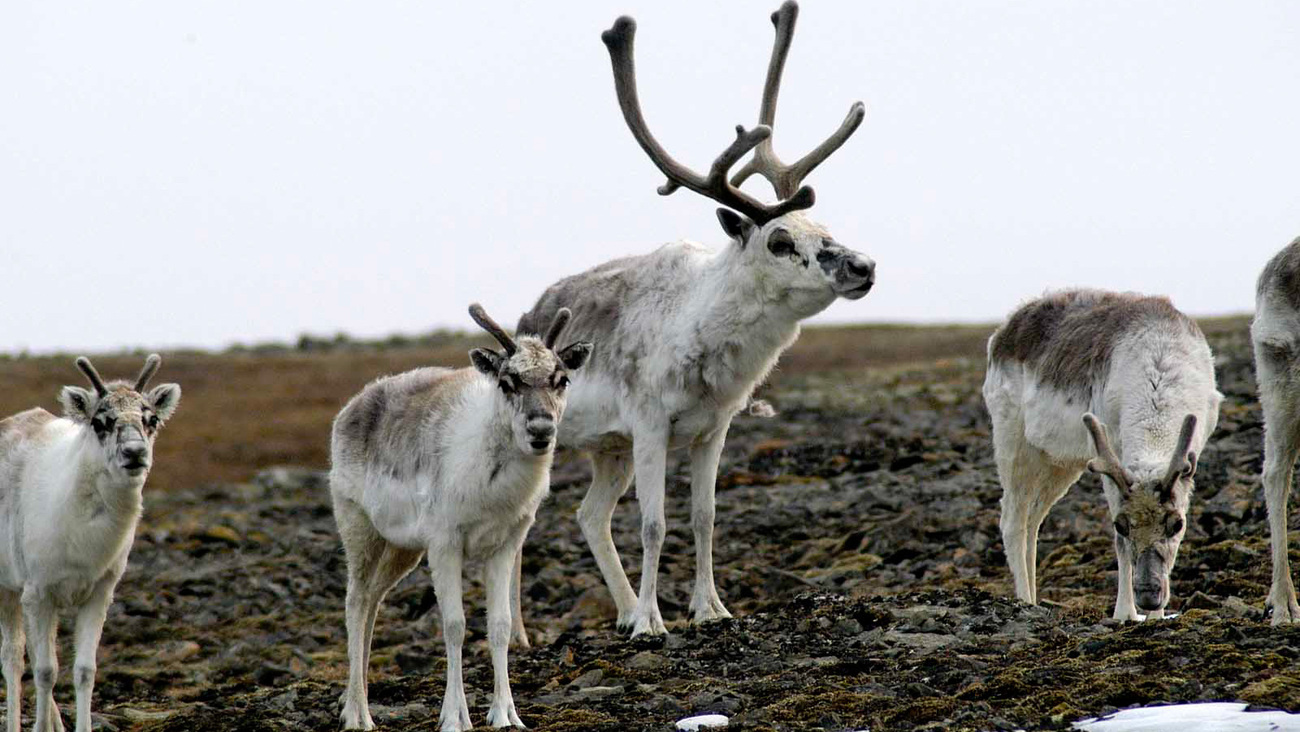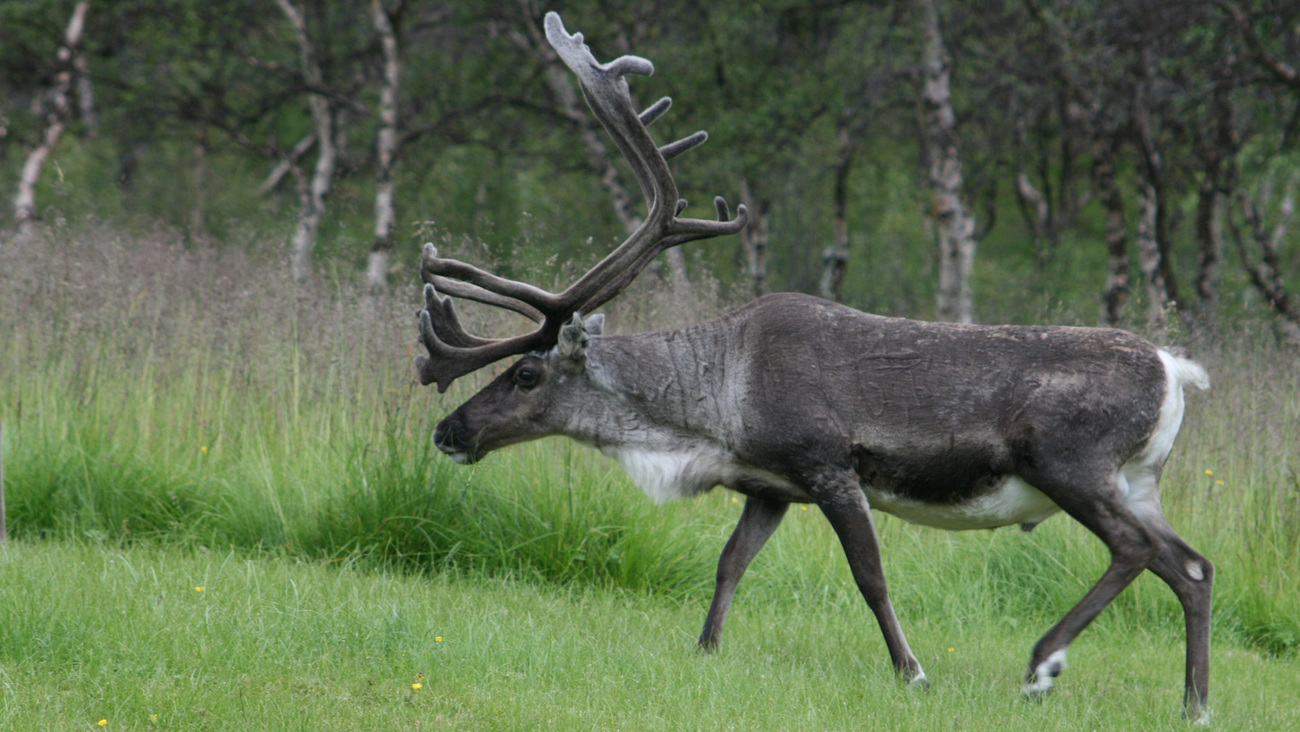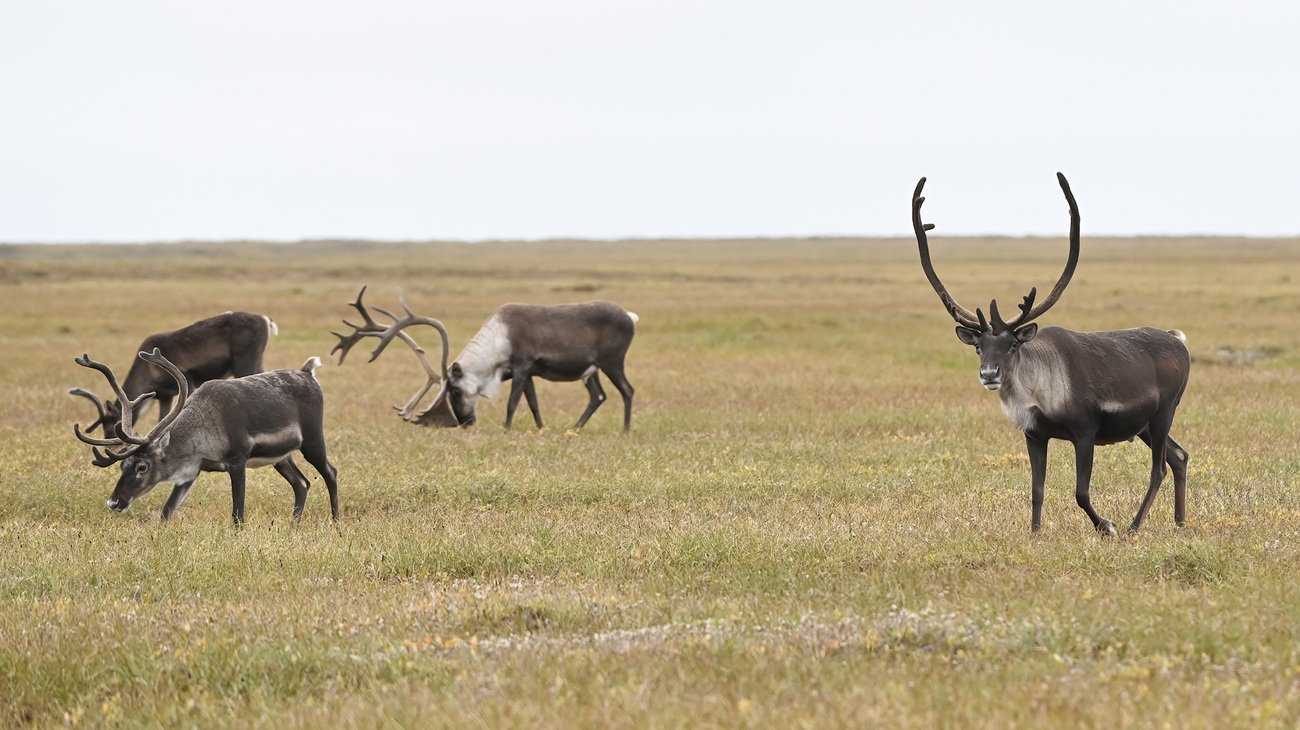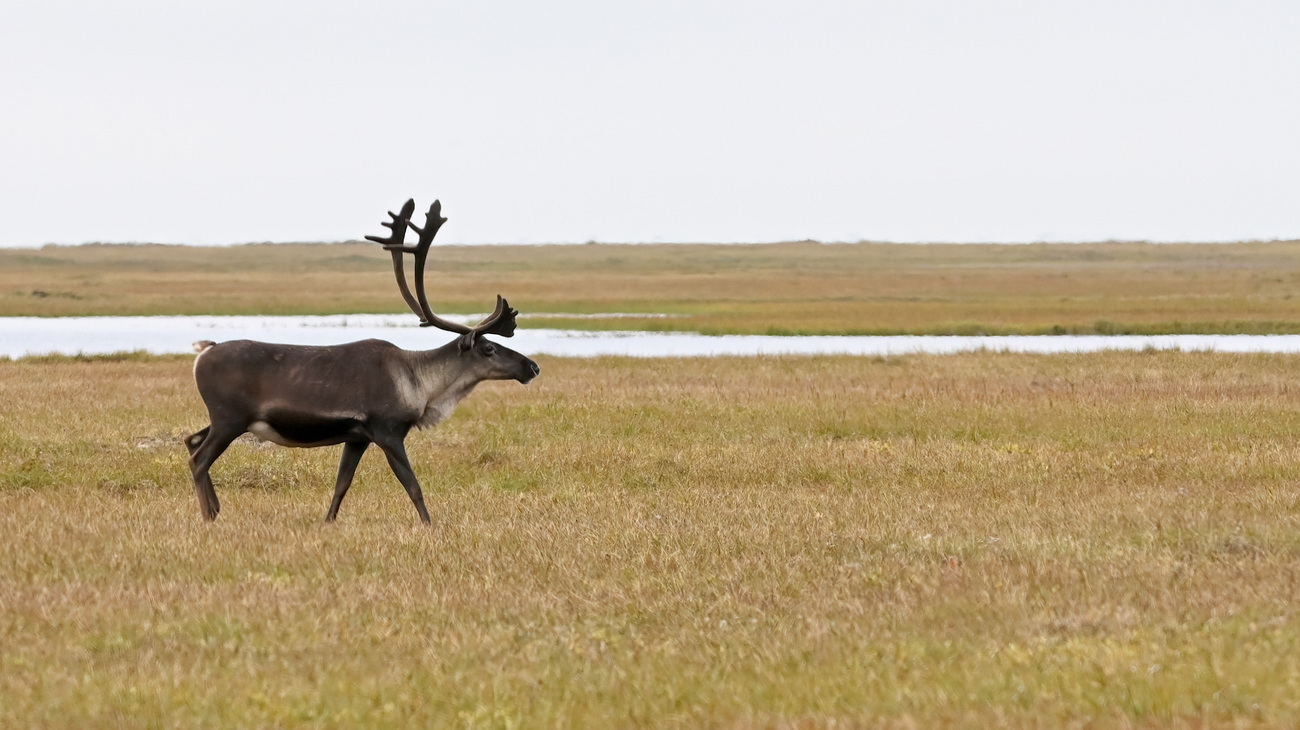Caribou
Caribou, also known as reindeer, are animals from the cervidae or deer family. Though the terms ‘caribou’ and ‘reindeer’ are sometimes used interchangeably and do refer to the same species, there is a key difference. ‘Caribou’ describes members of the Rangifer tarandus species living in North America, who migrate long distances annually. ‘Reindeer’ describes wild Rangifer tarandus living in Europe and Asia or domesticated caribou in North America.
Both male and female caribou grow antlers, which they shed and regrow every year. Female caribou give birth to one calf each year. Calves can stand within minutes of being born, and by the next day, they can even walk beside their mothers. This quick development helps young, vulnerable caribou survive against predators like wolves, bears, and lynx.
Caribou hooves are large enough to distribute their weight, which helps them walk easily on snow and paddle through the water. The hoof’s underside is hollow, which helps them dig through snow to reach lichens, their winter food source. Their hooves change slightly with the seasons. In the summer, the underside is spongy and soft to help them grip the earth, and in winter, it shrinks and hardens to help them better grip the ice.
Caribou and reindeer are important to their ecosystems and the local communities where they live. In the tundras and forests, they help regulate vegetation and cycle nutrients through the soil to encourage growth. Indigenous people use reindeer as draft animals, consume their milk, use their fur for warmth, and eat their meat.
What is a caribou’s scientific name?
The scientific name for reindeer and caribou is Rangifer tarandus. The term Rangifer likely comes from the Old French word rangier for reindeer and the Latin word ferus, which translates to ‘wild’ or ‘untamed’.
Are caribou endangered?
Caribou are classified by the IUCN as Vulnerable (VU). Prior to 2015, they were classified as Least Concern (LC). Caribou have experienced a population decline of 40% over the last three generations (21 to 27 years). The numerous threats contributing to this decline include habit disturbance through human activity, hunting, predation, and climate change.
Where do caribou live?
Caribou live in the Arctic tundra and the boreal forests of Greenland, Scandinavia, Russia, Alaska, and Canada. There are two different types of caribou and reindeer—tundra caribou and forest and woodland caribou. Tundra caribou are larger in numbers and migrate between tundras and forests areas every year. They migrate in massive herds that can reach up to 500,000 individuals.
Threats
Reindeer and caribou face several threats, including climate change, predation, habitat disturbance, and hunting—all of which contribute to their declining populations.

Habitat disturbance and human activity
The habitats of both tundra and forest caribou are changing due to increasing human development, including transportation infrastructure, energy production plants, tourist resorts, forestry, and more. This results in habitat fragmentation, separating caribou groups and making it more difficult for them to breed and migrate together. These changes can also affect the vegetation in these areas, directly limiting food availability for reindeer. These dangers are understood but are largely unmanaged.
Hunting
Unregulated hunting is believed to threaten caribou, but research is still incomplete. Hunting of reindeer has taken place for thousands of years and is an integral part of the culture of some communities. However, other threats and changing circumstances could lead to hunting becoming unsustainable. The social and political difficulties in regulating hunting could pose a greater problem in the future.
In Russia, reindeer are targeted by illegal hunters for their ‘velvet’ antlers. A velvet-like fuzz covers new antlers as they grow. This layer contains blood vessels and a growth hormone that helps the antlers grow as much as 2.5 centimetres per day.
Reindeer cross large rivers during their migration, and hunters go out onto these rivers in boats to catch reindeer and remove their antlers. Some cultures believe antler velvet has medicinal qualities. Antlers are often sold for this purpose, mainly in Russia and China.
Predation
As humans encroach on caribou habitats, more trails, roads, and open spaces make it more difficult for caribou to escape their predators. Wolves, bears, and lynx are among the main predators of caribou and reindeer. Predation is just one factor in a very complex web of factors leading to caribou’s decline, but some governments focus on combating predation to help protect populations.
In British Columbia, for example, the government has implemented an official wolf cull to reduce predation. However, the reasoning behind these culls is flawed, and their positive effects are negligible. These culls use poison, which causes immense suffering to wolves and can also affect non-target animals, including endangered species.
Climate change
Especially in Arctic regions, climate change causes rapid and complex effects that change the patterns of vegetation, snowfall and melting, and ice freeze-up and break-up. Climate change also causes an increase in icing events, which occur when rain falls on snow and creates a layer of ice. When this happens, the ice can prevent reindeer from accessing their food. Warming temperatures can also affect the distribution of mosquitoes, which recently caused outbreaks of the Setaria tundra parasite in reindeer in Finland.
FAQs
Are caribou reindeer?
Caribou and reindeer are the same species, Rangifer tarandus, but these terms describe different animals in different geographic locations. Caribou refers to wild animals living in North America. Reindeer refers to wild and domestic animals in northern Europe and Asia or domesticated animals in North America. Wild caribou migrate long distances across North America between their summer and winter grounds. Domesticated reindeer tend to live in one place.
Do caribou always have antlers?
Yes, caribou always have antlers—both males and females. Female caribou are the only female deer that grow antlers. Males shed their antlers during November, and females shed their antlers in May. In that case, one might suggest Santa’s reindeer must all be female because they all have antlers.
Where do caribou live?
Caribou live in tundras and forests in the US, Canada, Finland, Greenland, Mongolia, Norway, and Russia. They can be found in treeless tundra areas, boreal forests, or mountains. They migrate as far as 1,800 miles to their summer grazing lands and back again during the winter.

What are 5 facts about reindeer?
1. Despite their size, reindeer are not safe from predators. Wolves, bears, eagles, mountain lions, and lynxes all hunt and eat caribou.
2. Caribou are good swimmers and sometimes cross rivers and lakes in large herds during migration.
3. Caribou’s eyes change throughout the year. In the summer, their eyes are golden. In the winter, their eyes reflect light differently, causing them to look blue.
4. Although antlers look like they would take a long time to grow, caribou shed and regrow them every year. Males shed their antlers in November and grow them back in the spring. Females shed their antlers in May when they give birth to their calves.
5. Caribou are the only species of deer that are widely domesticated by humans. They are used as draft animals to pull sledges and carts and are farmed for their milk.
What are baby reindeer called?
Baby reindeer are called calves.
How big is a full-grown caribou?
When fully grown, caribou bulls generally weigh between 159 and 182 kilograms with some records reaching 318 kilograms. Females are always smaller, usually weighing around 80 to 120 kilograms. When you take antlers into account, a reindeer can far surpass a fully-grown male human in height, but the height of four-legged animals is usually measured up to their shoulder. For caribou, shoulder height is about 1 to 1.5 metres.
What do caribou eat?
As herbivores, caribou spend a lot of their time moving around and foraging for food. They eat a range of vegetation, including the leaves of willow trees, sedges, mushrooms, and flowering tundra plants in the summer. As autumn approaches, they start eating lichens (reindeer moss), dried sedges, and small shrubs. An adult caribou can eat as much as five kilograms of food each day.
Why do caribou have 4 stomachs?
Caribou fall under the suborder of Ruminantia, a group of mammals with two-toed feet and four-chambered stomachs. Giraffes, deer, cattle, antelopes, sheep, and goats are also ruminants. These four separate stomach chambers help them digest the plant material they eat. A lot of this material contains cellulose, a complex carbohydrate that ruminants can’t break down and digest.
Instead, when they first ingest food, it travels to the first chamber of their stomach and stays there for a while to soften. Later on, they regurgitate the food back into their mouths and chew it again to break down the cellulose content. Finally, they swallow it again and finish the process in the other three chambers of their stomachs, where microorganisms assist in digestion.
What is the biggest threat to caribou?
The biggest threat to caribou is habitat loss, degradation, and fragmentation. This is caused by a variety of factors, two of the most significant being human activity and climate change. When habitat changes, the consequences for wildlife can be severe. Habitat changes impact vegetation, species distribution, hunting success rates, breeding habits, food availability, diseases, viruses, and more.
What language does caribou come from?
The word ‘caribou’ is French Canadian and derives from the Micmac (Algonquian) term ‘kaleboo’ or ‘khalibu’, which means ‘pawer’ or ‘scratcher’. This name describes the caribou’s habit of kicking snow away from the vegetation it eats.

How can you help?
Caribou are threatened by human activity, predation, and climate change. IFAW is working to advocate for animals around the world.
